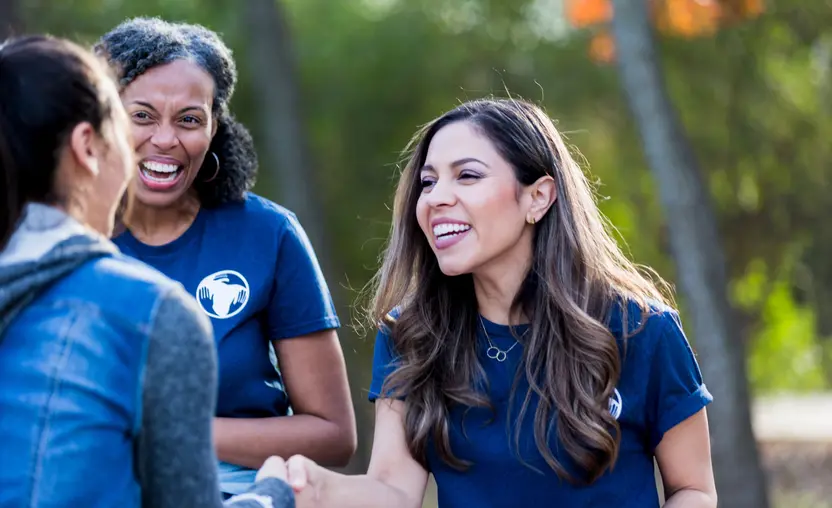Your current donors have already expressed an interest in your nonprofit organization’s purpose and have demonstrated a willingness to act on it. Plus, as a general rule, retaining existing donors costs less than acquiring new ones. This means for most nonprofits, focusing on donor retention is the most affordable strategy for sustainable fundraising.
However, nonprofit leaders report that their top fundraising challenges are donor fatigue and donor engagement, leading many organizations to struggle with retention.
To help your organization boost its retention success, we’ll explore the current state of donor retention for nonprofits and several strategies you can use to retain more donors long-term. But first, let’s answer some common questions about donor retention.
 The donor cultivation cycle has five phases: identification, research, cultivation, solicitation, and stewardship. Retention plays a major role in the stewardship phase, helping you bridge the gap between your first solicitation to the next. Without retention efforts, donors may lapse without giving another gift.
While your acquisition and cultivation efforts are important, retention is essential to cultivate a dedicated community for your organization.
When you prioritize engaging and upgrading the donors you already have, you’ll create a strong base of loyal, lasting support for your nonprofit. High donor retention means your organization has more stable, predictable sources of funding since the same donors give again and again. This leaves you better equipped to meet your fundraising goals in the long run.
The donor cultivation cycle has five phases: identification, research, cultivation, solicitation, and stewardship. Retention plays a major role in the stewardship phase, helping you bridge the gap between your first solicitation to the next. Without retention efforts, donors may lapse without giving another gift.
While your acquisition and cultivation efforts are important, retention is essential to cultivate a dedicated community for your organization.
When you prioritize engaging and upgrading the donors you already have, you’ll create a strong base of loyal, lasting support for your nonprofit. High donor retention means your organization has more stable, predictable sources of funding since the same donors give again and again. This leaves you better equipped to meet your fundraising goals in the long run.
 The FEP also provided the following donor retention statistics:
The FEP also provided the following donor retention statistics:

 In your plan, you might include actions and engagement activities like:
In your plan, you might include actions and engagement activities like:
 Then, use your segments to tailor your messaging and engagement efforts for each group. Taking the time to get to know your donors and offer them a more robust, personal supporter engagement experience will make them feel valued and, in turn, help drive their continued support.
Then, use your segments to tailor your messaging and engagement efforts for each group. Taking the time to get to know your donors and offer them a more robust, personal supporter engagement experience will make them feel valued and, in turn, help drive their continued support.
What is donor retention?
Donor retention refers to how many donors keep giving to your organization year after year. When nonprofit leaders use the phrase “donor retention,” they may be referring to either of two different but related concepts:- The percentage of donors your nonprofit retains from one time period to another (also called your donor retention rate)
- The efforts, strategies, and steps you take to engage donors and keep them committed to supporting your nonprofit long-term
Why is donor retention so important?
Donor retention has a major impact on on the overall fundraising success of your nonprofit or not-for-profit organization. To understand why, you need to understand retention’s place in the donor cultivation cycle.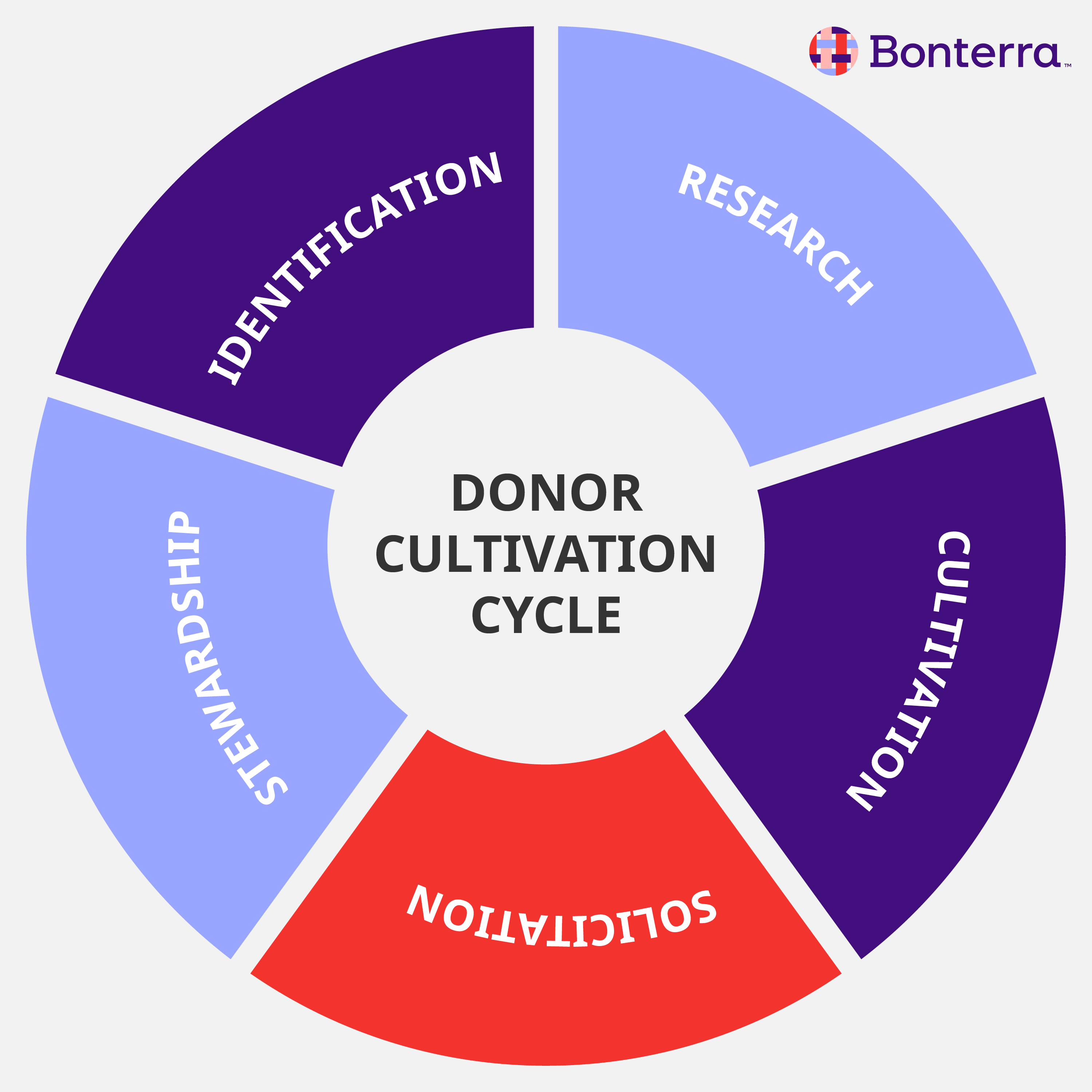 The donor cultivation cycle has five phases: identification, research, cultivation, solicitation, and stewardship. Retention plays a major role in the stewardship phase, helping you bridge the gap between your first solicitation to the next. Without retention efforts, donors may lapse without giving another gift.
While your acquisition and cultivation efforts are important, retention is essential to cultivate a dedicated community for your organization.
When you prioritize engaging and upgrading the donors you already have, you’ll create a strong base of loyal, lasting support for your nonprofit. High donor retention means your organization has more stable, predictable sources of funding since the same donors give again and again. This leaves you better equipped to meet your fundraising goals in the long run.
The donor cultivation cycle has five phases: identification, research, cultivation, solicitation, and stewardship. Retention plays a major role in the stewardship phase, helping you bridge the gap between your first solicitation to the next. Without retention efforts, donors may lapse without giving another gift.
While your acquisition and cultivation efforts are important, retention is essential to cultivate a dedicated community for your organization.
When you prioritize engaging and upgrading the donors you already have, you’ll create a strong base of loyal, lasting support for your nonprofit. High donor retention means your organization has more stable, predictable sources of funding since the same donors give again and again. This leaves you better equipped to meet your fundraising goals in the long run.
Donor retention statistics to keep an eye on
The state of donor retention is ever-changing, especially in light of recent giving trends that show declines in charitable giving to nonprofits across the board. With this in mind, it’s important to stay aware of donor retention trends and statistics that can help you position your organization’s retention within the wider nonprofit community. According to the 2023 Fundraising Effectiveness Project (FEP) Report, nonprofits’ donor retention rates “were boosted early in the year, but started going down again in July.” The FEP reports that donor retention dropped by 3.5% in 2023 compared to 2022 (although adjusted for late data, they anticipate the final result is likely closer to 2.5%). While this is a smaller decrease in donor retention compared to the past two years, it’s still important to keep this context in mind when looking at your own donor retention rates.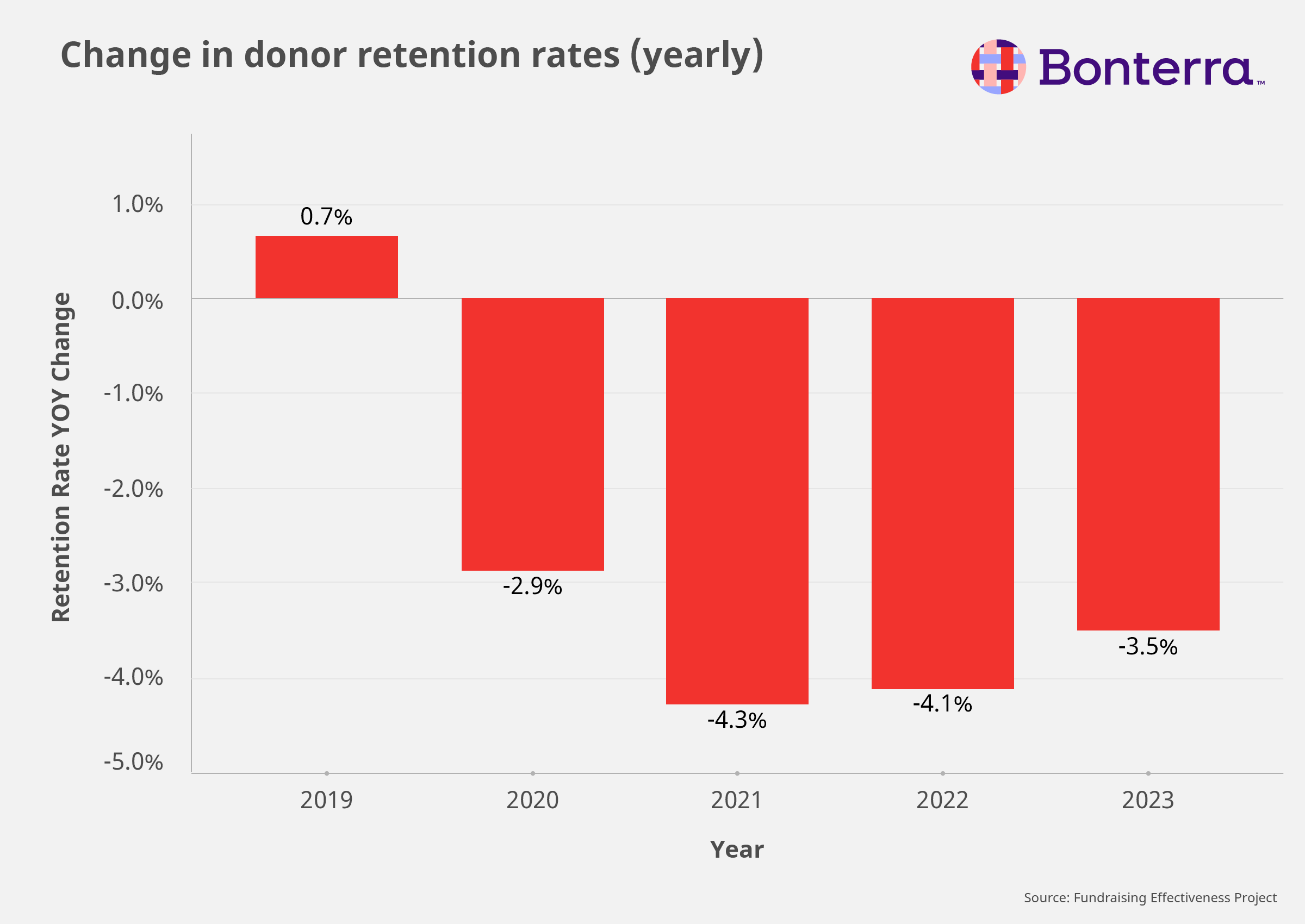 The FEP also provided the following donor retention statistics:
The FEP also provided the following donor retention statistics:
- New donor retention rate was down 7.5% from last year. The total percentage of new donors retained year-to-date was 18.5%.
- Repeat donor retention rate was down 1.1% from last year. The total percentage of repeat donors retained year-to-date was 58.2%.
- The number of retained major donors (who gave between $5,000 and $50,000) decreased by 6.0% year over year. The number of retained micro donors (who gave less than $100) also decreased by 4.2% year over year.
Calculating your donor retention rate
To calculate your nonprofit’s donor retention rate, you first need to choose a time frame, such as one year. Then, use this formula to find your retention rate for that period: (Number of returning donors in year two / Total number of donors in year one) x 100 = donor retention rate Say that you had 500 donors last year (year one). Of those donors, 170 of them returned and gave again this year (year two). Using our formula, (170 / 500) x 100 = 34. That means your donor retention rate for this year would be 34%.What is a good donor retention rate?
What constitutes a “good” donor retention rate can vary depending on a variety of factors. While the Fundraising Report Card reports that the current average donor retention rate is around 35%, many nonprofits consider anywhere from 35-45% to be a good overall donor retention rate. However, you should also consider the donor retention rates of specific groups, such as new donors and repeat donors or donors by giving level. According to the 2023 FEP Report, retention rates for new and repeat donors were vastly different: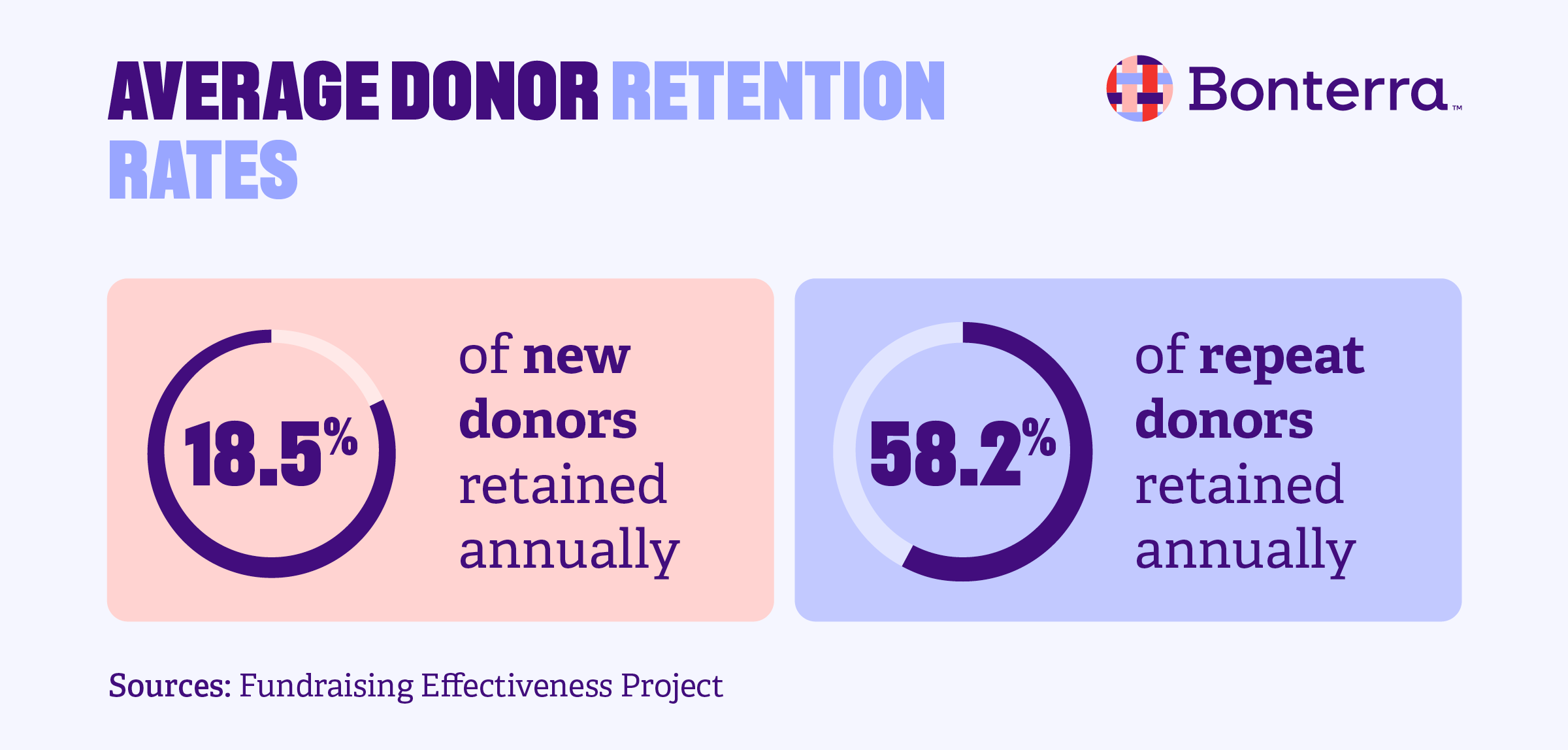
- For new donors, only 18.5% were retained YTD
- For repeat donors, 58.2% were retained YTD
7 donor retention strategies for improving retention rates
Successful donor retention efforts are about understanding what is important to donors and building trust with them. Knowing why your current donors support you is a springboard to keep them engaged and find like-minded donors in the future. To show your supporters that you appreciate them and boost your retention rates, try these evidence-backed tactics from nonprofit fundraising, engagement, and technology expert Kirstie Kimball of Build Power Strategies:1. Create a donor retention plan.
The first step to cultivating stronger support from your existing donors is to create a stewardship plan that maps out all of the ways you’ll inspire donors to sustain and deepen their involvement. Building donors’ loyalty to your organization means engaging them in a variety of ways outside of fundraising asks. This includes hosting donor appreciation events, sending personalized thank-you letters, and offering opportunities for continued engagement, such as volunteering or participating in surveys. Start prioritizing donor retention by creating a stewardship plan like the one below that maps out specific actions you’ll take at different stages of the donor journey.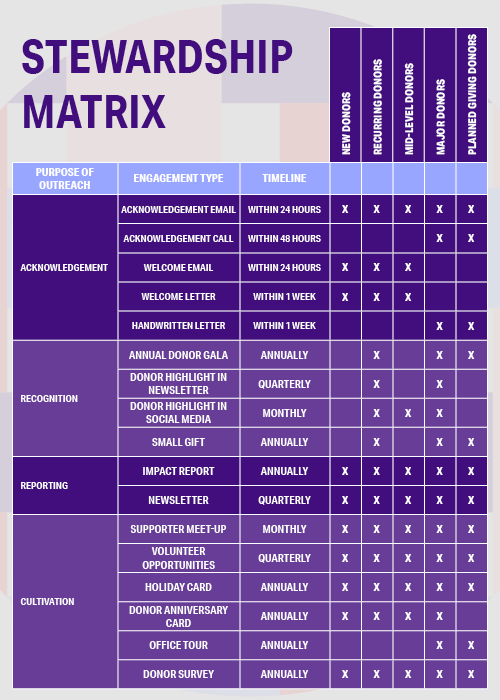 In your plan, you might include actions and engagement activities like:
In your plan, you might include actions and engagement activities like:
- Donation acknowledgment and thank-you calls, emails, and letters
- Invitations to galas, supporter meet-ups, office donors, or donor appreciation events
- Monthly newsletters and annual impact reports about your nonprofit’s work
- Cards to celebrate birthdays, anniversaries, and relevant milestones
- Opportunities for more involvement, like volunteering or peer-to-peer fundraising
2. Call donors to thank them personally.
As Kirstie Kimball explained in the video above, personal phone calls can be a powerful tool for donor retention. A phone call from a staff member, board member, or even a volunteer lets donors know that your organization cares about them personally and wants to connect further. Include phone calls in your communication plans for all types of donors, not just your major or lead donors. Consider inviting regular volunteers to take the lead on these phone calls, but make sure to provide them with a basic script that prioritizes appreciation and impact. Donors want to hear from you, especially in a personal way. They may be excited to discuss your organization’s future and how they fit into it. One phone call can inspire them to increase their giving level, sign up for more involvement opportunities, or just keep your nonprofit top-of-mind.3. Leverage a unified donor management system.
Having a centralized database or custom donor management system to track donors and your interactions with them is crucial for successful donor retention. Make sure that your donor database or constituent relationship management (CRM) system enables you to do the following:- Track your retention rates: Seeing your donor retention statistics in real time on a visual dashboard will help you stay aware of your progress and any trends that arise. If possible, set up reports for donor retention rates for specific groups as well.
- Automate recapture and renewal efforts: By automating your email outreach, you can send donors a personalized message as soon as they begin to lapse. This kind of improved supporter experience will help donors re-engage with your work sooner and save your staff time.
- Store donor preferences: Collect and analyze information about donors to identify patterns in their communication preferences, interest in specific projects or initiatives, and motivations for supporting your cause.
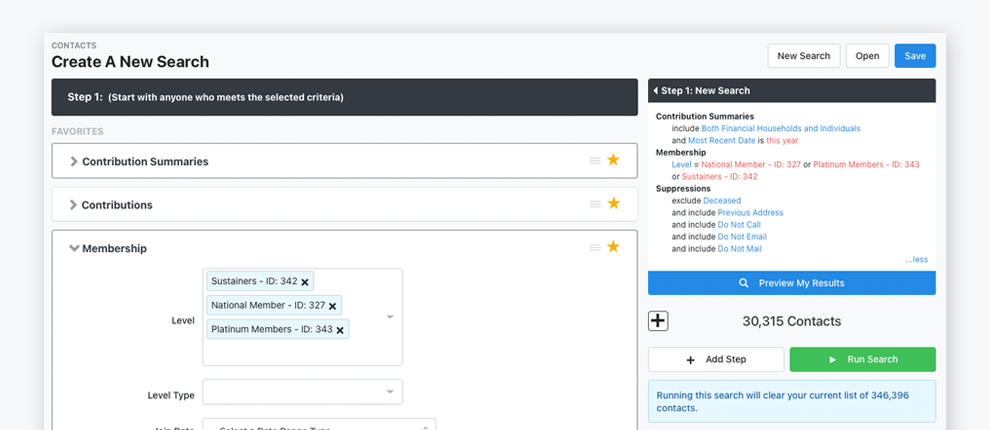 Then, use your segments to tailor your messaging and engagement efforts for each group. Taking the time to get to know your donors and offer them a more robust, personal supporter engagement experience will make them feel valued and, in turn, help drive their continued support.
Then, use your segments to tailor your messaging and engagement efforts for each group. Taking the time to get to know your donors and offer them a more robust, personal supporter engagement experience will make them feel valued and, in turn, help drive their continued support.
4. Demonstrate your nonprofit’s impact.
Donors want to know that their contributions make a tangible difference to your nonprofit. Your cause is the reason they give, and they need to know their donations make an impact in order for them to keep giving. In fact, one of the top reasons donors lapse is that they don’t know how their gifts are being used. To demonstrate impact and boost retention, provide regular updates on how you use supporters’ donations to reinforce their commitment to your cause. Use email blasts, annual reports, newsletters, webinars, and blog and social media posts to share the results of your work and enhance donor relationships. For instance, an animal shelter might send a first-time donor the following personalized email: “Thanks to your $100 contribution, we were able to provide free medical care to Luna, a German shepherd puppy who was suffering from parasites. Because of generous donors like you, our furry friend is wagging her tail again.”5. Provide more engagement opportunities.
Engaging donors beyond giving means you need to provide plenty of relevant, appealing engagement opportunities. This often involves a regular cadence of touchpoints and communications that highlight opportunities for:- Volunteering
- Attending events
- Taking part in advocacy efforts
- Providing feedback on your programs and initiatives
- Joining a membership program
6. Set the stage for major gifts.
Major gifts don’t have to be million-dollar contributions to have a significant impact. Every organization can and should be soliciting major gifts, no matter what your threshold is. Focus on ways to engage with individual donors who have the ability and willingness to make larger gifts to your organization than they currently do. You already have access to potential major donors within your existing donor pool, and using your data will help you identify the top prospects who fit these criteria. Your next major gift will likely come from one of these donors who has both the capacity to give and a history of frequent involvement with your organization. Once you’ve identified those with greater financial capacity and affinity for your cause, segment these donors for more targeted attention, such as tailored solicitations, one-to-one communications, and unique experiences. Form a dedicated group of staff and volunteers to focus on stewarding these donor relationships.7. Widen your reach through existing donors.
A healthy fundraising plan combines a focus on retaining the donors you already have with cultivating the next pipeline of donors to your organization. Fuse these strategies by letting your existing donors help you discover new prospects. The best potential new donors are people who are already connected to your nonprofit in some way. Use these tactics to grow your donor base through your current supporters:- Test out a peer-to-peer fundraising program to connect with your current donors’ wider social networks
- Include a sign-up option on your website and at events so potential donors can receive your communications
- Leverage your board members’ and volunteer leaders’ networks to see where their connections can open doors
Focusing on donor retention long-term
Engaging your existing donors will help you develop lasting relationships, locate new prospects, and increase your overall fundraising revenue. Be mindful that if your funding generally comes from one source more than any other, it’s time to create balance. Discuss the ways you can improve and diversify your retention strategy with your board or development committee, then work to continue prioritizing donor retention long-term.
Bonterra Fundraising + Engagement is the best tool for engaging and retaining your donors.
